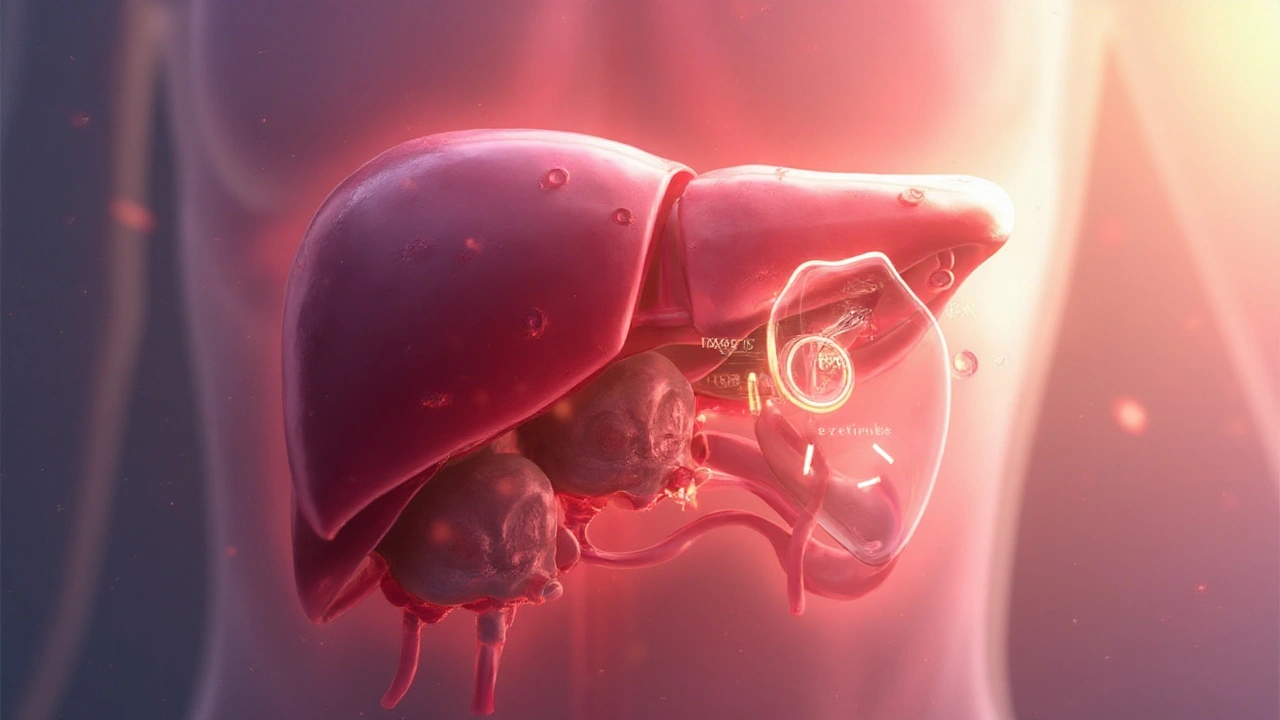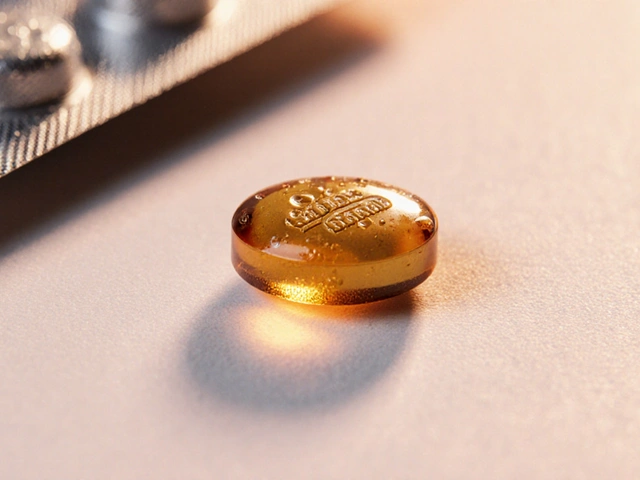TL;DR
- Zetia (ezetimibe) blocks cholesterol absorption in the gut.
- Typical dose is 10mg once daily, with or without food.
- Works best when added to a statin or when statins aren’t tolerated.
- Common side effects: stomach upset, headache, fatigue.
- Check for interactions with bile‑acid sequestrants and certain antibiotics.
Understanding Zetia: How It Works and Who Can Benefit
When you hear the name Zetia, think of a tiny blocker that stops the intestine from sucking up the cholesterol you eat. The active ingredient, ezetimibe, targets a protein called NPC1L1 on the lining of your small intestine. By inhibiting this protein, less dietary and biliary cholesterol reaches your bloodstream, which in turn lowers your low‑density lipoprotein (LDL) levels.
Why does this matter? For most adults, high LDL is a major risk factor for heart disease and stroke. Statins-drugs that block the liver’s cholesterol production-are the first line of defence. However, many patients can’t reach target LDL levels on statins alone, or they experience side effects like muscle pain. That’s where Zetia shines: it offers an extra push without the muscle‑related issues that some statins cause.
Typical candidates for Zetia include:
- People on a moderate‑intensity statin who still have LDL>100mg/dL.
- Patients who are statin‑intolerant due to liver or muscle concerns.
- Individuals with familial hypercholesterolemia who need aggressive LDL reduction.
- Those who prefer a non‑statin option for mild cholesterol elevation.
Clinical trials from 2017‑2022 consistently show that adding 10mg of ezetimibe to a statin can shave an additional 15‑20% off LDL levels. In real‑world practice, the average drop hovers around 18% when combined with a low‑to‑moderate dose of atorvastatin.

Using Zetia Safely: Dosage, Side Effects, Interactions, and Monitoring
The prescribing guide is simple: one 10mg tablet once daily, taken with or without food. No titration is needed-just start and stay on the same dose unless your doctor says otherwise.
Because Zetia works in the gut, it isn’t heavily processed by the liver, so it has a low potential for serious liver toxicity. Still, some people notice mild gastrointestinal upset. Here’s what to watch for:
- Common (1‑10%): abdominal pain, diarrhea, nausea, fatigue, headache.
- Less common (0.1‑1%): elevated liver enzymes, allergic skin reactions.
If you experience persistent stomach pain, dark urine, or yellowing of the skin, contact your clinician right away.
Drug‑drug interactions are relatively few, but a few important ones exist:
- Bile‑acid sequestrants (e.g., cholestyramine): can bind ezetimibe in the gut, reducing its effectiveness. Space them at least 1hour apart.
- Fibrates (e.g., gemfibrozil): may increase the risk of gallstones when combined with statins+Zetia.
- Cyclosporine: can raise ezetimibe levels modestly; monitor kidney function.
Routine labs are part of safe use. Baseline and follow‑up tests should include:
- Lipid panel (fasting) at 4‑6 weeks after starting or adjusting therapy.
- Liver function tests if you’re also on a statin.
- Kidney function (creatinine) if you have chronic kidney disease.
Below is a quick reference table summarising typical dosing and expected LDL reductions.
| Regimen | Average LDL Reduction | Key Notes |
|---|---|---|
| Zetia 10mg alone | ~18% | Useful for statin‑intolerant patients. |
| Zetia 10mg + moderate‑intensity statin | ~30‑35% | Achieves targets for most high‑risk patients. |
| Zetia 10mg + high‑intensity statin | ~40% | Reserved for very high cardiovascular risk. |
Remember, lifestyle still matters. Diet, exercise, and smoking cessation amplify the drug’s impact. Think of Zetia as a turbo‑boost for a healthy foundation you’re already building.

Practical Tips, FAQs, and Next Steps for Patients
Even with clear instructions, patients often have lingering questions. Below are the most common queries and concise answers.
| Can I take Zetia if I’m pregnant? | Safety in pregnancy hasn’t been established. Discuss alternatives with your doctor. |
| Do I need to continue taking it for life? | Usually yes, unless your cholesterol stays in target after a lifestyle overhaul and your doctor decides otherwise. |
| Will I feel any immediate effect? | No. Cholesterol changes are measured in blood tests after weeks of consistent use. |
| Can I crush the tablet? | The tablet can be taken whole or split in half, but avoid crushing as it may affect absorption. |
| What if I miss a dose? | Take it as soon as you remember unless it’s almost time for the next dose. Then skip the missed one. |
**Next steps** for anyone considering Zetia:
- Schedule a blood test to get a baseline lipid profile.
- Talk to your GP or cardiologist about whether Zetia fits your risk profile.
- Ask about potential interactions with any supplements you take (e.g., green tea extracts, herbal remedies).
- Set a reminder to take your tablet at the same time each day.
- Re‑check your lipids 4‑6 weeks after starting; adjust therapy if needed.
By staying informed and following these practical steps, you can make the most of Zetia’s cholesterol‑lowering power while minimizing unwanted side effects. If anything feels off, reach out to your healthcare provider-your safety is always the top priority.






Comments
Ben Small
21/Sep/2025Grab your Zetia daily like a power‑up and watch those LDL numbers dip!
Chidi Anslem
21/Sep/2025The mechanisms of ezetimibe extend beyond simple cholesterol blockade.
By inhibiting NPC1L1, it reduces both dietary and biliary cholesterol influx.
This dual action can be especially valuable for patients whose statin therapy has plateaued.
Clinical evidence from 2017 through 2022 consistently shows an additive LDL reduction of roughly 15‑20%.
Such numbers may appear modest, yet they translate into meaningful cardiovascular risk mitigation over years.
Moreover, the drug’s hepatic metabolism is minimal, which accounts for its relatively benign liver safety profile.
Patients frequently report only mild gastrointestinal discomfort, a trade‑off many find acceptable.
In populations with familial hypercholesterolemia, combining ezetimibe with moderate‑intensity statins can bring LDL below guideline thresholds.
It is also noteworthy that ezetimibe does not exacerbate statin‑associated myopathy, a common concern among clinicians.
When considering drug interactions, the timing with bile‑acid sequestrants is crucial to preserve efficacy.
A one‑hour separation between the two agents is widely recommended.
Monitoring should include baseline lipid panels and periodic liver function tests, especially if a statin is co‑prescribed.
Patients should be reminded that lifestyle modifications remain the cornerstone of therapy.
Diet, exercise, and smoking cessation amplify the pharmacologic benefits and can sometimes reduce the need for higher drug doses.
In sum, ezetimibe serves as a versatile adjunct, offering clinicians a low‑risk tool to fine‑tune cholesterol management.
Holly Hayes
21/Sep/2025i think it s ok but watch out for stomach upset
Penn Shade
21/Sep/2025Statins remain the first‑line therapy, but the addition of ezetimibe is not a mere afterthought; it can shave an extra 15‑20% off LDL. The data supporting this synergy are robust and come from multiple large‑scale trials. Ignoring this option may leave many patients under‑treated.
Jennifer Banash
21/Sep/2025Behold, the humble tablet that dares to challenge the tyranny of cholesterol! With a single 10 mg dose, it quietly obstructs the gut’s hungry grasp for lipids, sparing the liver from further burden. Its elegance lies in its simplicity-no titration, no complex regimen, just steadfast daily adherence. Yet, let us not be deceived; even modest agents demand respect and vigilant monitoring.
Stephen Gachie
21/Sep/2025Ezetimibe’s role reminds us that medicine is both art and science, a balance of modesty and ambition. By targeting intestinal absorption it sidesteps hepatic pathways, reducing hepatic strain. Such a mechanism invites contemplation of where else we might intervene without overloading the liver. Hence, its place in therapy is both logical and poetic.
Sara Spitzer
21/Sep/2025The evidence is clear: ezetimibe works, but it is not a miracle cure. Over‑promising results only fuels disappointment. A realistic expectation paired with lifestyle changes yields the best outcomes.
Jennifer Pavlik
21/Sep/2025Start the pill with a glass of water and keep a weekly reminder. This simple habit can make a big difference.